Emperor Penguins of Antarctica Expedition
- November 18th, 2026 - November 26th, 2026
- Spaces Left: 7 (Maximum 8 Photographers)
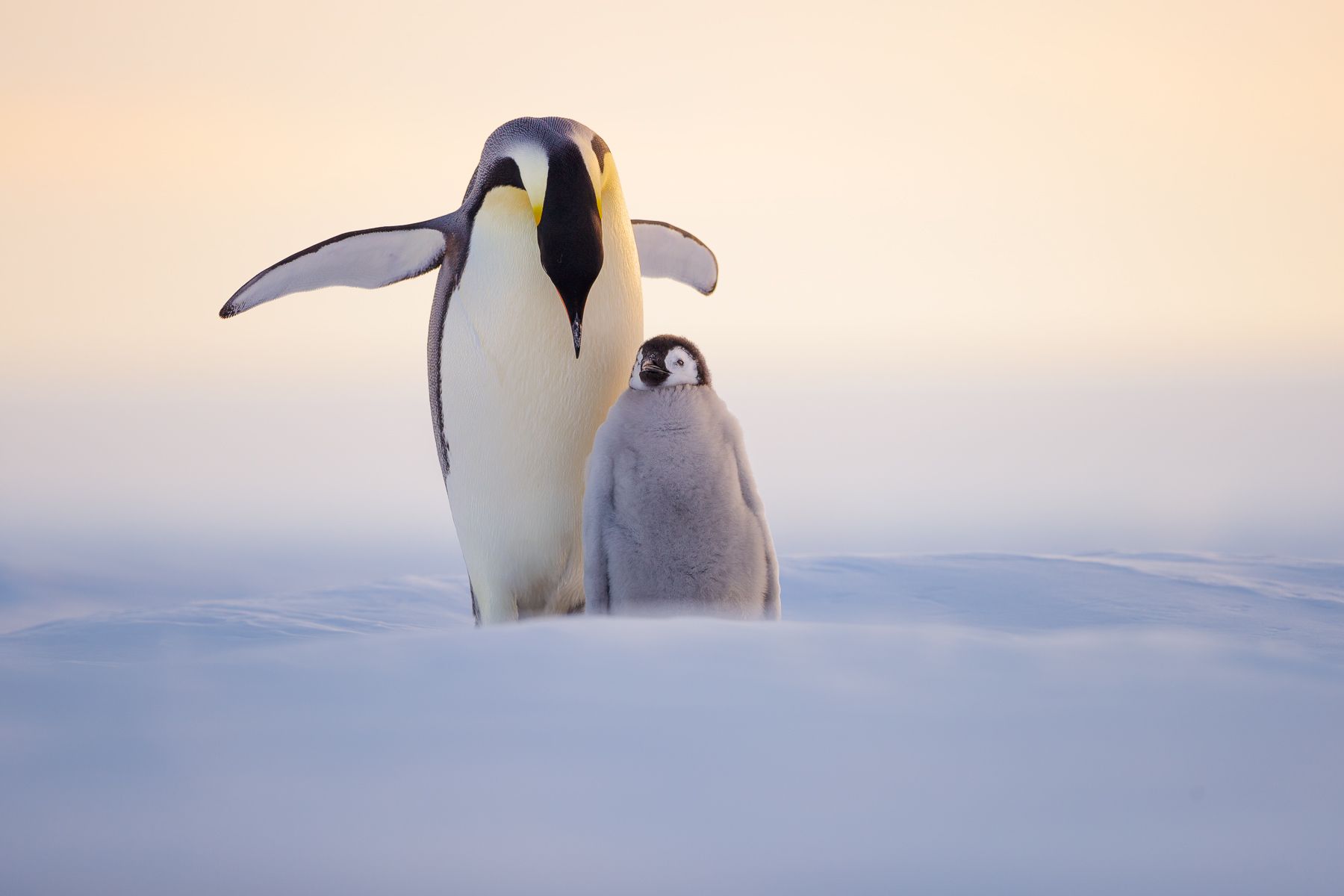
WORKSHOP AT A GLANCE
This unique custom-tailored workshop to photograph the mighty Emperor Penguins on the sea ice of Gould Bay in Antarctica is for keen and passionate wildlife photographers who want to capture dramatic and powerful photographs of Emperor Penguins living on the sea ice. The sea ice of Gould Bay in the Weddell Sea is the best place in the world to photograph Emperor Penguins under the midnight sun. We have a small group size and personal, one-on-one tuition for the duration of the workshop. There will also be landscape opportunities during this workshop, although our primary focus is Emperor Penguins.
- Dates: November 18th, 2026 until November 26th, 2026 (8 nights / 9 days)
- Why Travel with Us: Wild Nature Photo Travels Point of Difference
- Investment: $64,900 +/- 10% USD final costings are set by the flight logistics).
- Deposit: Deposit to secure place $6,000 USD with a further progress payment and balance due 120 days before the workshop commences.
- Participants: Maximum 8 Photographers plus leader
- Start and Finish: Punta Arenas, South America
- Trip Leaders: Joshua Holko Master Photog II
- Fitness Level: Moderate
- Temperature: Freezing
- Experience Level: Intermediate to Professional
ABOUT THIS WORKSHOP
In November 2026, I will lead a once-in-a-lifetime expedition experience deep into Antarctica to photograph the mighty Emperor Penguins. The expedition will see us photographing the world's most southerly Emperor Penguin colony on the sea ice at Gould Bay, deep in the Weddell Sea.
This expedition is for a limited number of just eight photographers, plus a leader. We will travel by a privately chartered transport jet deep into Antarctica, landing on a pre-prepared ice runway. From our base camp, only 600 miles from the South Pole, we will take a privately chartered Twin-Otter ski aircraft to the remote Emperor Penguin colony on the sea ice. We will establish a field camp on the sea ice and photograph the Emperors and Emperor Penguin Chicks on the sea ice against a backdrop of incredible mountains, icebergs, and pressure ridges. We will photograph throughout the night when the light is soft and golden in an expedition opportunity dedicated to photography. If you are excited about travelling to one of the remotest regions in Antarctica to live and photograph with the majestic Emperor Penguins, now is the time to register your place by using the Register Online link at the bottom of this page. Places are strictly limited, and once spoken for, that's it.
About Emperor Penguins: The emperor penguin (Aptenodytes forsteri) is the tallest and heaviest of all living penguin species and is endemic to Antarctica. The male and female are similar in plumage and size, reaching 122 cm (48 in) in height and weighing anywhere from 22 to 45 kg (49 to 99 lb). The dorsal side and head are black and sharply delineated from the white belly, pale-yellow breast and bright-yellow ear patches. Like all penguins, it is flightless, with a streamlined body and wings stiffened and flattened into flippers for a marine habitat. Its diet consists primarily of fish but can also include crustaceans, such as krill, and cephalopods, such as squid. In hunting, the species can remain submerged up to 18 minutes, diving to a depth of 535 m (1,755 ft). It has several adaptations to facilitate this, including an unusually structured hemoglobin to allow it to function at low oxygen levels, solid bones to reduce barotrauma, and the ability to reduce its metabolism and shut down non-essential organ functions. The only penguin species that breed during the Antarctic winter is the emperor penguin, who trek 50–120 km (31–75 mi) over the ice to breeding colonies that may include thousands of individuals. The female lays a single egg, which the male incubates while the female returns to the sea to feed; parents subsequently take turns foraging at sea and caring for their chick in the colony. The lifespan is typically 20 years in the wild, although observations suggest that some individuals may live to 50 years of age.
The emperor penguin has a circumpolar distribution in the Antarctic almost exclusively between the 66° and 77° south latitudes. It almost always breeds on stable pack ice near the coast and up to 18 km (11 mi) offshore. The emperor penguin is a social animal in its nesting and its foraging behaviour; birds hunting together may coordinate their diving and surfacing. Individuals may be active day or night. In 2012 the emperor penguin was uplisted from a species of least concern to near threatened by the IUCN. Along with nine other species of penguin, it is currently under consideration for inclusion under the US Endangered Species Act.


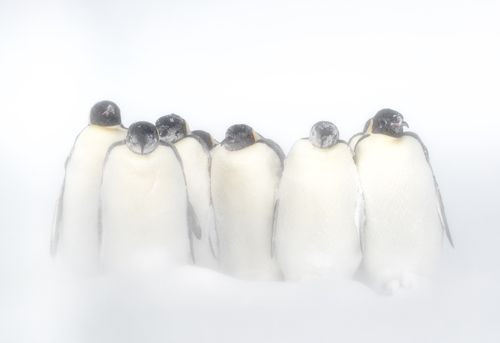
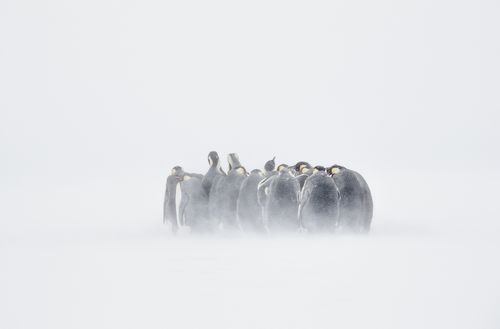
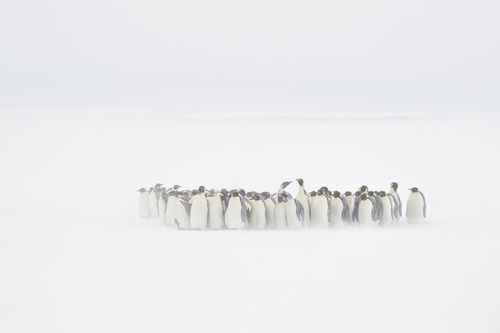
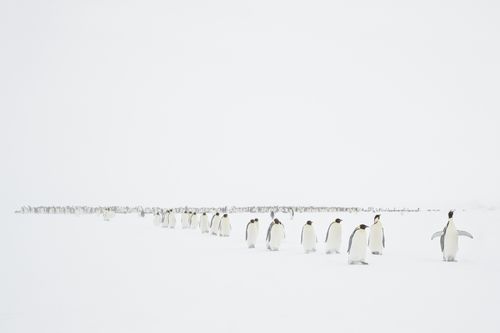
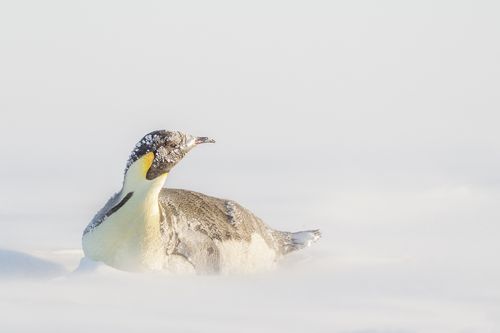

WORKSHOP ITINERARY
Day One - Start your Antarctic Expedition: Pick up from your hotel in Punta Arenas and transfer to the local airport. Fly from Chile to Union Glacier in Antarctica by private transport jet. Land on the blue-ice runway and settle in at our Union Glacier Camp. The Union Glacier Camp is only accessible by air and is the only facility of its kind in Antarctica. Our flight time is approximately 3 ¼ hours from Punta Arenas, Chile. Our wheeled aircraft lands on a naturally-occurring, fully maintained ice runway on the Union Glacier, where we will take our first steps onto the Antarctic continent. We then climb aboard a specially adapted winterized vehicle for the 5-mile (8km) ride to camp.
At this point in the expedition, we will be 1,870 miles (over 3000km) from the southern tip of Chile and only a stone’s throw away from Mount Vinson, the highest peak in Antarctica. The South Pole is just over 600 miles (1000km) away. Our geographic location is 79°46’S 82°52’W. And our elevation 2, 297ft (700m) above sea level.
Our first stop upon arrival in Antarctica will be the Union Glacier Base Camp. The camp is located in the southern Ellsworth Mountains on the broad expanse of Union Glacier. The setting is spectacular, and majestic peaks rise in all directions offering plenty of opportunity for photography. The accommodation is spacious and comfortable, and meals are prepared fresh daily.
Day Two – Union Glacier Basecamp: Today is an easy day to acclimatize to Antarctic conditions at our Union Glacier Base-camp. We will have an orientation to camp and life in Antarctica, review expedition logistics, and explore and photograph the spectacular mountains and landscape.
Safety and Comfort: Much goes on behind the scenes to ensure your safety and comfort on the ice. Communications experts keep regular contact with the outside world. Heavy equipment mechanics maintain and operate a fleet of transport and runway maintenance equipment. Our meteorologist provides weather information to flight crews. And general support staff do the thousand-and-one tasks that keep camp in tip-top shape.
Sleeping Accommodations: Our double-walled sleeping tents are roomy and comfortable. They are well suited to Antarctic conditions and are based on a design used by Shackleton’s Endurance expedition. Each tent houses two guests. You sleep in your polar sleeping bag with a double mattress, pillow and linen, which are provided for you. The tents are naturally heated by the 24-hour sunlight, and interior temperatures range from 25°F – 68°F (4°C- 20°C).
Dining: The dining tent is the heart of our camp. It has a full kitchen and dining area and serves as a gathering place for meals, activities and conversation. You will enjoy hearty, fresh-cooked meals, baked goods and tantalizing desserts prepared by the chefs. Self-serve snacks and beverages are available anytime. We regularly fly in fresh fruits, vegetables, fish, meats and a variety of beers and Chilean wines from Punta Arenas, Chile. Wine and beer are served with dinner.
Medical: Union Glacier has a small clinic staffed by a doctor and medic. They are available to treat minor injuries and illnesses. In case of a medical emergency the camp stocks a selection of medications and fundamental equipment for the care and stabilization of patients
Power and Charging: Camp systems are solar-powered to minimize our environmental impact. We are able to offer limited solar/charging facilities during your stay. You will need a 12V DC-DC charger capable of plugging in to a “female” cigarette lighter socket, or a 110V charger with North American plug, to use the system. You will be able to charge camera batteries and other portable electronic devices.
Communication and Meteorology: Good communication and weather information are crucial for safe operations. The camp is equipped with satellite phone, VHF and UHF radio to maintain regular contact with the outside world, aircraft and other bases. You can make outgoing Iridium phone calls from Union Glacier. Pre-paid phone cards may be purchased at the camp. Our meteorologist uses local observations, information from our automatic weather stations and satellite imagery to provide wind and weather information to flight crews, climbers and expeditions.
Day Three – Emperor Penguin Advance Camp: After breakfast, we pack up from our Union Glacier Base camp and fly by Twin-Otter ski aircraft to the remote south coast of the Weddell Sea. We land on multi-year sea ice near the Emperor rookery, and our guides set up a cozy field camp beside the aircraft. The rest of the day is ours to explore, and we will have our first audience and photography session with the Emperors. We will photograph majestic Emperors against a spectacular backdrop of ice cliffs, pressure ridges and icebergs.
Day Four - Eight – Emperor Penguin Advance Camp: Days four, five, six, seven and eight are spent living with the Emperors at our advance camp. We can experience the rhythms of the rookery at our own pace over the five days. Meal times are flexible, so you can photograph and explore when the lighting and mood are just right. Meals are prepared by our chefs so that you are free to focus on your photography. Meals provided include hot meals (breakfast, lunch and dinner) and portable snacks. Watch and photograph adults display and feed their young. Each night, we will fall asleep to the mingled calls of thousands of Emperors. As we are camping next to the rookery, the opportunity to take photographs extends 24 hours a day.
Emperor Penguin Camp Location: Our Emperor Penguin camp is located in the southern Weddell Sea at Gould Bay. It is an entirely ice-fronted embayment formed by the Ronne Ice Shelf and the northern tip of Berkner Island. The elevation is sea level. Gould Bay was discovered by the Ronne Antarctic Research Expedition (RARE) (1947-1948), which researched the area surrounding the head of the Weddell Sea. It was named for Laurence M. Gould, geologist, geographer, and second in command of the Byrd Antarctic Expedition (1928-1930)
The Light for Photography: We will have 24-hour daylight throughout our stay with the Emperor Penguins. Our camp schedule will be based on Union Glacier/Chile time (UTC-3) but we may find ourselves keeping odd hours to take advantage of the best light and weather conditions. Often the light for photography is best in the middle of the ‘night’ and it is not uncommon to visit the colony at 2 or 3 am to take pictures in the soft, golden sunlight. Meal times are adjusted accordingly and there is always hot food available when we get back to camp.
The Walk to the Emperor Colony: Our Emperor Penguin advance base-camp is approximately one kilometre walk from the main Emperor Penguin colony. The walk is flat across the frozen sea ice, and we utilize small sleds to pull our camera equipment along behind us. The small sleds also allow us to take a thermos for hot drinks, snacks, and spare clothing. Sleds and walking poles will be provided for you at the Emperor Penguin Advance Camp.
The Emperor Penguin Advance Camp in Detail: Our Emperor Penguin field camp provides a simple yet comfortable ‘nest’ from which to explore the nearby Emperor Penguin rookery. The camp is on frozen sea ice, just in front of the Ronne Ice Shelf, roughly 420 miles (676 km) from the main base at Union Glacier, making it one of the most remote camps in the world and the only Antarctic camp on sea ice! The Emperor Penguin field camp is run each year just for the Emperor Penguin viewing season, and the season is extremely short, consisting of approximately twenty days. The field site is very carefully chosen to avoid disturbing the penguins in any way. Tents are set up approximately one mile (1.6 km) away from the rookery and, where possible, screened from the penguins’ view by an iceberg or other natural feature. A flagged route marks the path between the rookery and our camp. At the end of the viewing season, the camp is taken down, and everything, including human waste, is removed.
Campsite Facilities: Camp facilities are necessarily more modest than at our Union Glacier base-camp. Equipment must be lightweight and portable yet still strong enough to withstand Antarctic conditions. Facilities are designed to provide as much comfort as possible while minimizing our environmental footprint. Meals are served in a small, heated dining tent. The expedition includes both set meals and available snacks to provide penguin viewing and photography flexibility. Accommodation is in two-person mountaineering tents like those used by alpine ascent teams. The sleeping tents are unheated, but you will stay nice and warm with your insulated sleeping mat and polar-rated sleeping bag. The small tent size and double occupancy accommodation also maximize heat retention. A shared solar re-charging station is provided for camera batteries and other portable electronic devices. Toilet facilities are housed in a dedicated bathroom tent. They are basic, but private and kept spotlessly clean. All waste is returned to Union Glacier Camp for proper disposal.
Day 9 – Return to Punta Arenas Chile *: At the end of our last day we pack up the Twin-Otter aircraft and fly back to Union Glacier Camp, where we will enjoy a celebration dinner and share stories and photographs of our time living in one of the remotest parts of Antarctica with the Emperor Penguins.
The jet transport aircraft will then arrive and take us on the final leg of our Antarctic experience. You will be met at Punta Arenas airport when we land and transfer to your hotel, where we will conclude our expedition.
* Schedule: No two Antarctic experiences are the same. This is part of the excitement and adventure of Antarctic travel. The exact timeline and details will vary from trip to trip, and the length of the trip may vary by departure.
Please anticipate delays and do not plan anything for at least a week after your scheduled return. Allow yourself to enjoy this unique experience without the stress of pending commitments. The weather plays a very large part in our itinerary and timing, and whilst every effort is made to minimize delays, it is not uncommon for expeditions to be delayed due to weather.
FREQUENTLY ASKED QUESTIONS
How Cold will it Be?
Our expedition takes place during the Antarctic summer when the weather is at its best. We advise on suitable clothing so that you can enjoy your trip to the fullest. The interior of Antarctica has a cold, dry, windy climate. Average mid-season temperatures at our base camp range from 10F to 25F (-12C to -4C ). On a sunny, windless day, it can feel quite warm, but when the wind blows, you will be glad for warm layers and a wind jacket. Temperatures can drop as low as -22F (-30C) in early November. Weather at the Emperor's rookery is highly variable and influenced by coastal systems. Temperatures range from -22F (-30C) to near 32F (0C), with sunny and overcast skies and the possibility of heavy snowstorms.
Do I Need Travel and Evacuation Insurance?
All participants are required to provide cover for medical evacuation, due to the high cost of evacuation from Antarctica. We also strongly recommend that you consider Trip Cancellation and Interruption insurance to protect you in case you need to cancel for any reason.
Will the itinerary be exactly the same as documented?
Our itinerary is meant as a guide to give you an idea of how our expedition may unfold. However, no two trips are the same - and that is part of the excitement and adventure of Antarctic Expedition travel. Flight schedules are flexible, and you should expect delays due to the unpredictable nature of Antarctic weather, runway conditions and other logistics.
When should I arrive?
We ask that you arrive in Punta Arenas, Chile at least two full days (48 hours) before the scheduled departure. This allows time for clothing and equipment checks and provides a buffer in case you should miss a flight connection or have lost luggage. An environmental and logistics briefing will be held the day prior to departure. We will collect your luggage and load the aircraft that afternoon, ready for an early flight the following day. Please note that we cannot hold Antarctic flights for delayed arriving guests or lost luggage. We recommend that you give yourself plenty of time to enjoy your trip without the stress of tight timelines.
Can I fly my drone/UAV in Antarctica?
The use of drones in Antarctica is controversial. If you wish to fly a drone, we ask that you please contact us for the latest advice on any restrictions that may apply.
I’m not sure I have the correct equipment?
We will provide you with a detailed clothing and equipment list prior to the expedition so that you have plenty of time to prepare. If you still have questions after reading our equipment lists and overview, just drop us a line, and we will be more than happy to help. We can also arrange rental clothing for you.
What Camera Equipment Should I bring?
The choice of camera equipment is a personal one. In general, however, we recommend you bring a 35mm mirrorless camera system with various focal lengths from wide-angle to medium telephoto. We will send you a detailed recommended list of equipment, so you have plenty of time to prepare for the expedition.
Why Does this Expedition cost more than Other Ship Style Journeys?
A large proportion of the cost of this expedition involves the privately chartered Jet Transport and Twin-Otter aircraft that we will use to reach our Base-camp at Union Glacier and the Advance field camp on the sea ice at the Emperor Penguin rookery. There are also significant logistics costs associated with operating these remote camps. Flying into Union Glacier and then taking a second ski aircraft is the only way to guarantee access to the Emperors. We understand this makes it more expensive and that, as a result, this expedition may not be for everyone.
Can I touch the penguins?
No. Penguins, seals and other Antarctic wildlife need to conserve energy in order to survive and raise their young. It is essential that you keep your distance and avoid causing them stress. All Antarctic wildlife are protected under the Antarctic Treaty, and visitors may not touch, feed or disturb them in any way. Please see IAATO’s Emperor Penguin Viewing Guidelines. We will also explain the wildlife-watching procedures and help you follow them in the field.
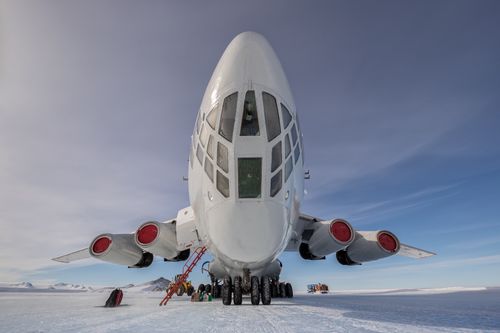
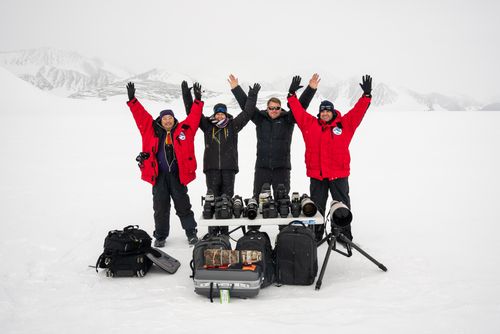
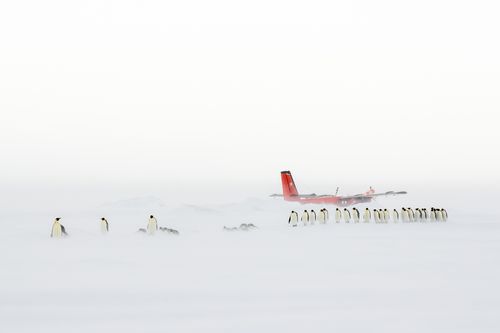
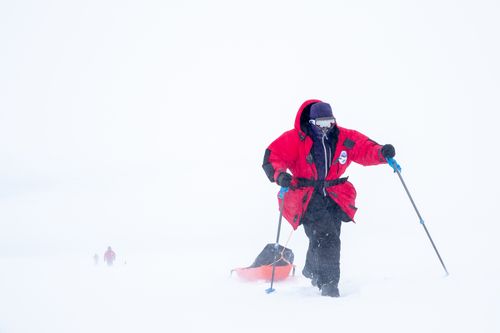


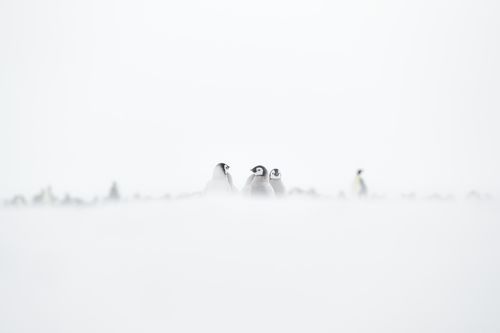
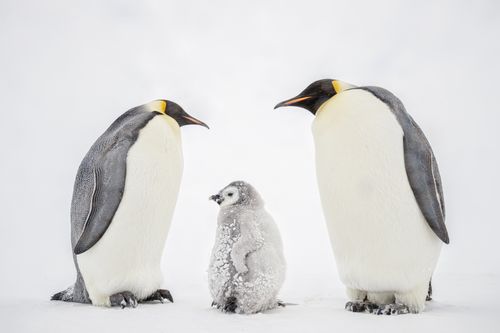
INCLUSIONS AND EXCLUSIONS
Inclusions
- Briefing: Private briefing with refreshments in Punta Arenas one day before departure.
- Transportation: Private charter round-trip flights from Punta Arenas, Chile, to Union Glacier, Antarctica. Private charter Twin-Otter round-trip flights from Union Glacier to the Weddell Sea Emperor Penguin camp on the sea ice. Luggage transfers as required in Antarctica.
- Accommodation: Accommodation at Union Glacier and at the Emperor Penguin sea ice camp in expedition tents for the duration of the workshop.
- Food and Beverages: All meals & beverages in Antarctica for the duration of the expedition.
- Equipment: Use of recreational equipment at Union Glacier Base Camp. Use of supplied expedition tents for the duration of the expedition.
- Tuition: Expedition Guide, Naturalist, and expert one-on-one Photographic tuition and guiding services.
Exclusions
- Transportation: Any travel required to arrive at the expedition starting location in Punta Arenas, South America
- Duties and Taxes: Any taxes, levies, insurances, Immigration, duty, and visa fees where applicable.
- Personal Items: Personal equipment and clothing (polar clothing can be rented). Any personal items, including alcoholic beverages, souvenirs and travel insurance. Optional Gratuities for camp and expedition staff, at your discretion.
Alcohol: Alcoholic drinks other than those offered at dinner
Communications: Telephone, Satellite phone or internet charges
Delays: Expenses incurred in Punta Arenas due to delays
Insurance: Insurance coverage – personal, medical, evacuation or otherwise
Fuel: Fuel is included in the expedition cost based on a rate of $1 USD per litre in Punta Arenas. If the fuel cost in Punta Arenas increases by more than 5%, we reserve the right to charge a ‘fuel-price increase’ surcharge.
Other: Any private excursions, activities, or services not explicitly included in the itinerary.
TERMS AND CONDITIONS
A deposit of $6,000 USD must be made at the time of booking to secure your place, with a further progress payment of $30,000 USD by the 1st of March 2026 and the balance due 120 DAYS before the workshop commencement date. Deposit Methods Accepted: Credit card Visa/Master (+3%) or Direct Deposit / Wire Transfer.
Refunds and Cancellations: Our standard workshop policy requires an initial non-refundable deposit for the reservation of your space and your payment balance in full 120 days before the commencement of the workshop date unless otherwise noted. If we do not receive the balance on or before the due date, and we are unable to get in contact with you via the contact details you have provided, we will try to fill your spot off the waiting list. At our discretion, we may apply your deposit to be used for another workshop within one year. Please note that price increases may apply in this instance.
If the workshop is cancelled for any reason, your deposit will be refunded in full. Wild Nature Photo Travel Pty Ltd., trading as Joshua Holko Photography and Joshua Holko, is not responsible for any financial commitments that registered attendees have with third parties such as airlines or other travel services.
READ FULL TERMS AND CONDITIONS
Travel Insurance: You must purchase travel and evacuation insurance in the event of illness or any other emergency that delays or otherwise prevents you from travelling on the trip. Wild Nature Photo Travel partners with and recommends Global Rescue for Evacuation and Medical insurance.
REGISTER FOR THIS WORKSHOP
If you are excited about photographing the world's largest and most photogenic penguin - the Emperor Penguin - in a stunning ice landscape with a small group of like-minded, passionate photographers, now is the time to register your interest. Places are extremely limited, and once spoken for, that's it.